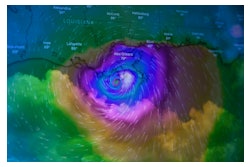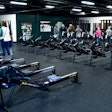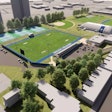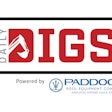This article originally appeared in the May 1989 issue of AB.
When artificial turf broke onto the sports scene in 1966 at the Houston Astrodome (hence, the first and still most famous brand name for synthetic grass: AstroTurf), a lot of people looked on it as a quirk. The Astrodome was the only major enclosed stadium at the time and not many people could envision using artificial glass outdoors where real grass could grow just fine.
A lot of years have gone over the dam since then, however, and there seems little doubt that artificial turf is here to stay. Not only are there more enclosed stadiums being built every year, but artificial turf is being used in increasing numbers of outdoor installations, even those in benign climates that could sustain year-round natural grass growth.
Some things change and some things stay the same. AstroTurf is still with us, though its creator, Monsanto Co., sold the product line to a West German company, Balsam Sportstatenbau, last year.
Along the way, a lot of AstroTurf’s competitors have dropped by the wayside. Today, there are essentially four major football/baseball field artificial turf products in North America: AstroTurf, All Pro, Poligras and Omniturf.
Another company, Sports Systems Inc., has found a strong niche market for indoor soccer and softball installations, marketing a product called Autograph Turf.
The essence of the product is largely the same today as it was in the 1960s, but, as in any product category, technology marches on.
Technological Growth
Many of the most significant changes in turf technology have taken place “in the last five to 10 years,” says Robert J. Johnston of R.J. Johnston & Associates, based in Calgary, Alberta. Johnston, and architect, has been involved in sports surface research and testing in connection with the Olympic Oval in Calgary, the University of Alberta and, most recently, as sports surface consultant to the new Skydome project in Toronto.
Among the most obvious changes, says Johnston, has been the advent of sand-filled systems, which have been widely introduced in Europe for soccer and field hockey installations, but which have also made inroads in North America.
Sand-filled turf, as the name implies, features fine-grit sand between the turf fibers. Their theory is that the sand helps keep the tur fibers upright and also reduces friction between the athlete’s feet and the surface.
Another change, related to the sand-filled systems, says Johnston, has been the development of a rubber-composite shock pad, usually made from a combination of styrene buterdyne rubber (SBR), which has commonly been used as a sheet-goods pad or in situ, or poured-in-place, says Johnston.
Some of the sheet-good products also have a convoluted bottom, much like and egg carton, which is designed to create air pockets between the pad and the asphalt base.
Refinements
Other technological changes have tended to be refinements of existing technology and nearly all manufacturers have adopted the changes into their products. There are three major areas of change:
- Porous fields: Unlike many of the original turf surfaces, which were essentially impervious to water, says Johnston, most of the new surfaces permit water to pass through the surface and the pad to the base, where it can drain away, into the ground or laterally along the asphalt.
Among the obvious advantages of the system, says Troy Squires, vice president of All Pro/OmniTurf Athletic Surfaces, is that the crowned field, which is designed to allow water to run to the sidelines, is no longer necessary. (Crowned fields are also common in natural grass football installations.)
This is especially appreciated by soccer and field hockey players, “although you still see a lot of crowned fields for football,” says Squires, a 10-year veteran of the turf industry, “because that’s what they’re used to. They’d feel strange on a flat field, but the crown isn’t necessary.”
Some systems also feature a water-permeable sub-base, which allows water to drain all the way through to the soil. Such systems may be especially useful in areas with significant annual rainfall.
- Shock pad improvements: The most common types of shock-absorbing materials are foam-type pads, the main component of which is usually either polyvinyl chloride or polyethylene, says Johnston.
Today’s pads tend to be thicker than earlier versions, but the most significant change may be in the switch from open-cell to closed-cell construction. The newer closed-cell construction prevents water from filling the cells of the foam, which makes the pad vulnerable to freeze-thaw cycles that damage the integrity of the pad
- Fiber technology: Most turf fibers are made from either nylon or polypropylene, and both types have undergone changes.
“The products are all well stabilized now in terms of their ability to resist ultraviolet degradation,” from the sun’s rays, says Johnston.
In terms of improved playability, the biggest change has been the advent of twisted or crinkled fibers that tend to maintain their upright posture and also avoid the “directionality” problem that some owners found in the past. In essence, straight fibers sometimes tended to lean all in one direction, so that athletes running in one direction experienced too much traction, while those running in another experienced too little.
Horizons
While the past 20-odd years have brought technological change, those familiar with the industry expect to see continued change and also changes in the available market.
There has tended to be a perception that artificial turf was too expensive for anything other than professional or major college installations. However, the turf was originally intended to serve small facility users and, in fact, the first artificial turf installation—coming nearly two years before the Astrodome’s—was at Moses Brown School, a private prep school in Providence, R.I. This year, AstroTurf is marketing the 25th anniversary of that pioneering 1964 installation.
Charlie Meeks, vice president of Poligras USA Inc. and a former Olympic soccer coach, says the European experience has been virtually the opposite of North America’s.
In much of Europe, especially West Germany, the “sport for all” movement has put a priority on developing public recreation areas before elite sport facilities.
“In Berlin, for example,” says Meeks, “they have about 280 recreation fields and 58 of them have artificial surfaces. It’s starting to happen here and I think if people locally start demanding better recreation facilities, the money will be there.”
There are indications that artificial turf has made inroads into recreation facilities.
Fran Oblak, president of Sports Systems, for example, notes that in addition to a number of indoor soccer arenas used by Major Indoor Soccer League and American Indoor Soccer Association teams, her company’s product has also found a market among the growing number of private indoor soccer and softball facilities that have sprung up. Typically, these facilities rent time to teams and leagues year-round, but especially in the winter.
“I think this market is going to grow,” says Oblak, “because people want to continue to play their sports all year long.”
Squires also says that small colleges and high schools are beginning to be less reluctant to pay the higher up-front costs for an artificial turf installation, especially when they see the use neighboring schools get out of their fields.
“It’s like a ripple effect,” says Squires. “Once one school does it, the others in the area begin to see that if you look at the investment over a 10-year period, it’s not really a luxury.”
Squires and Meeks both believe the same thing will eventually happen with college intramural and community recreation facilities that need a multi-use surface.
More Knowledge
Users are also better able to select and/or design a turf installation to fit their needs than they might have been in the past. In helping to select the turf for Toronto’s Skydome, for example, Johnston was able to test various turf types, including pads, at the University of Calgary’s Human Performance Laboratory, which is headed by noted biomechanist Benno Nigg. Johnston helped design the lab while he was design coordinator for the university’s facility development project prior to the 1988 Winter Olympics.
Using force platforms and digitized film, Johnston and Nigg were able to evaluate the performance of each surface under both material and subject tests to weigh the strengths and weaknesses of each.
Eventually, those test results, along with site factors and, “of course, cost,” says Johnston, helped Skydome developers decide on the best artificial surface for them.
Ultimately, because the Skydome will be used for both baseball (the American League Blue Jays) and football (the Canadian Football League Argonauts), as well as for other sports and non-sports events, the developers selected a traditional removable system that can be rolled up and stored in 15-foot widths. It’s also a traditional sandless system with a foam pad.
While that choice fit the Skydome’s needs, says Johnston, test results showed that “different products had different strengths in different areas,” so the desirability of any product might depend largely on what the user wants.
Technology, across the board, appears to continue to make strides.
“It’s like a snowball effect,” says Squires. “The research just keeps making more products available.”
































